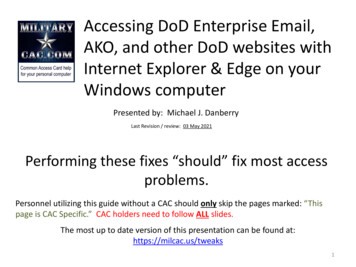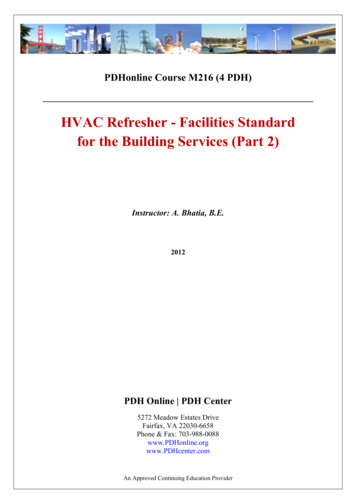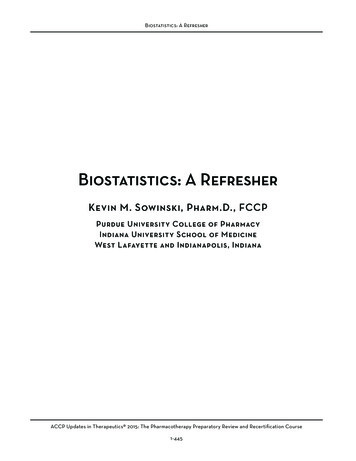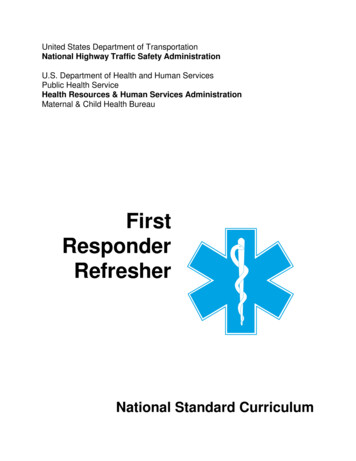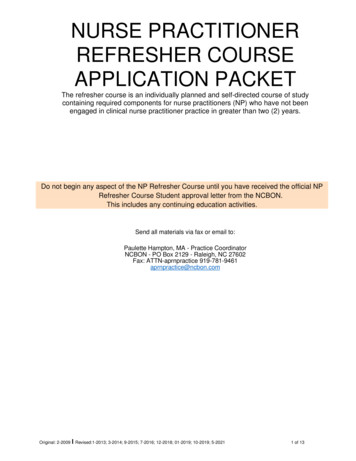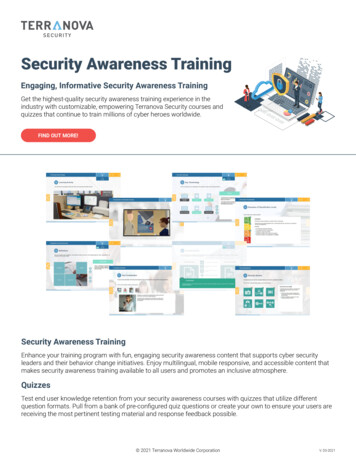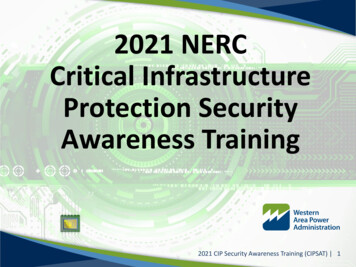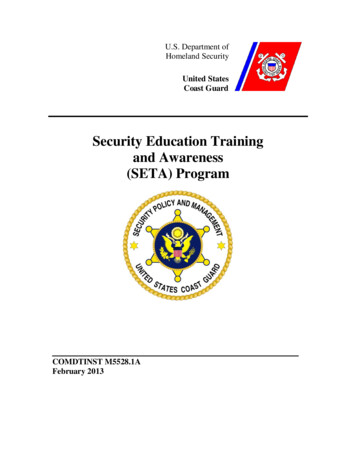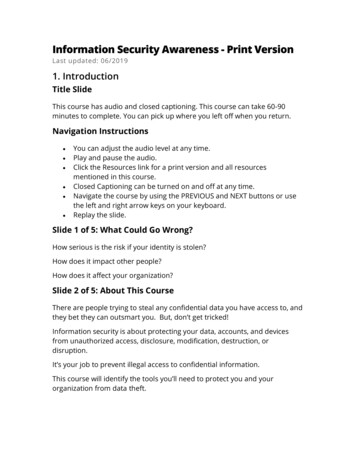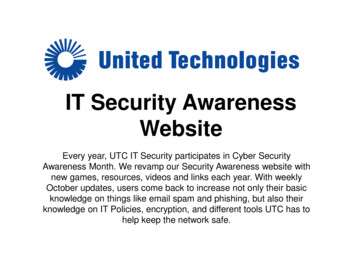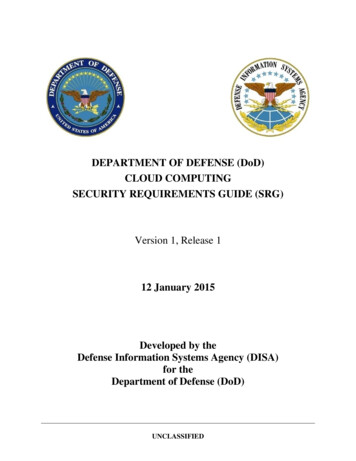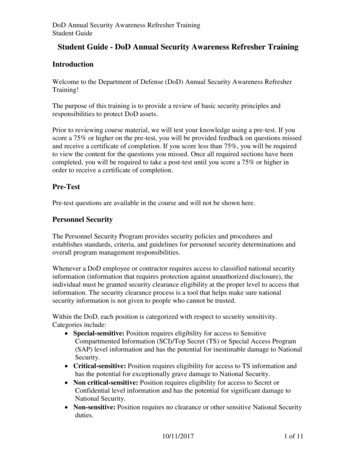
Transcription
DoD Annual Security Awareness Refresher TrainingStudent GuideStudent Guide - DoD Annual Security Awareness Refresher TrainingIntroductionWelcome to the Department of Defense (DoD) Annual Security Awareness RefresherTraining!The purpose of this training is to provide a review of basic security principles andresponsibilities to protect DoD assets.Prior to reviewing course material, we will test your knowledge using a pre-test. If youscore a 75% or higher on the pre-test, you will be provided feedback on questions missedand receive a certificate of completion. If you score less than 75%, you will be requiredto view the content for the questions you missed. Once all required sections have beencompleted, you will be required to take a post-test until you score a 75% or higher inorder to receive a certificate of completion.Pre-TestPre-test questions are available in the course and will not be shown here.Personnel SecurityThe Personnel Security Program provides security policies and procedures andestablishes standards, criteria, and guidelines for personnel security determinations andoverall program management responsibilities.Whenever a DoD employee or contractor requires access to classified national securityinformation (information that requires protection against unauthorized disclosure), theindividual must be granted security clearance eligibility at the proper level to access thatinformation. The security clearance process is a tool that helps make sure nationalsecurity information is not given to people who cannot be trusted.Within the DoD, each position is categorized with respect to security sensitivity.Categories include: Special-sensitive: Position requires eligibility for access to SensitiveCompartmented Information (SCI)/Top Secret (TS) or Special Access Program(SAP) level information and has the potential for inestimable damage to NationalSecurity. Critical-sensitive: Position requires eligibility for access to TS information andhas the potential for exceptionally grave damage to National Security. Non critical-sensitive: Position requires eligibility for access to Secret orConfidential level information and has the potential for significant damage toNational Security. Non-sensitive: Position requires no clearance or other sensitive National Securityduties.10/11/20171 of 11
DoD Annual Security Awareness Refresher TrainingStudent GuideThe Personnel Security Clearance Process ensures members of the Armed Forces, DoDcivilian employees, DoD contractor personnel, and other affiliated persons are grantedaccess to classified information and/or assignment to a national security sensitive positionconsistent with the interests of national security. The Personnel Security ClearanceProcess includes Investigation, Adjudication, Periodic Reinvestigation, and SelfReporting throughout the process.InvestigationsThe Revised Federal Investigative Standards (FIS), signed in 2012, establishesrequirements for conducting Federal background investigations to determineeligibility and will be implemented using a phased approach. The revised FISutilizes a new five-tiered investigative model. For the purposes of this course, wewill only focus on Tier 3 and Tier 5 security background investigations,adjudications, periodic reinvestigations, and self-reporting.The FIS Tier 3 and Tier 5 security background investigations are conducted fornational security positions to determine your eligibility for: Access to classified information Acceptance or retention in the Armed Forces Assignment to a designated national security sensitive positionYour refusal to complete security documentation may result in the revocation ordenial of your eligibility.AdjudicationsAfter the investigation is completed, the case is sent to Adjudications to assess theprobability of future behavior that could have an adverse effect on NationalSecurity. The DoD Consolidated Adjudications Facility (DoD CAF) is theprimary authority for making security clearance eligibility determinations forDoD Personnel. Each case is weighed on its own merits utilizing the whole personconcept, which looks at all available and reliable information about anindividual’s past and present prior to reaching an adjudicative determination.Periodic ReinvestigationUnder the FIS, there are two types of periodic reinvestigations for nationalsecurity clearances: Tier 3 R: Required for continued Secret and Confidential clearanceeligibility. Tier 3R periodic reinvestigations will continue to be conductedevery ten years. Tier 5 R: Required for continued TS or SCI clearance eligibility. Tier 5reinvestigations have been extended from five years to six years with DNIendorsement.10/11/20172 of 11
DoD Annual Security Awareness Refresher TrainingStudent GuideFor more information see the DoD Memorandum “Extension of PeriodicReinvestigation Timelines to Address the Background Investigation Backlog”located in the course resource page.Self-ReportingAs part of the Security Clearance process, you must self-report any changes instatus, adverse information, and foreign contacts as they occur to the SecurityOffice. Remember, if you don’t self-report, someone else might! Reporting doesnot automatically result in revocation of eligibility so don’t be afraid to report!Change in StatusSome examples of change in status would be: Marriage/co-habitation,addition of a new family member, divorce, or the receipt of a large sum ofcash (i.e., lottery).Adverse InformationAdverse information must also be reported, but what is adverseinformation? “Any information that adversely reflects on the integrity orcharacter of a cleared employee, which suggests that his or her ability tosafeguard classified information may be impaired or that his or her accessto classified information clearly may not be in the interest of NationalSecurity.” Some examples of adverse information that you must reportinclude: Criminal activity, including domestic violence or issuance of arestraining order, driving under the influence/driving whileintoxicated (known as a DUI or DWI) and traffic tickets in excessof 300 Excessive indebtedness or recurring financial difficulties andbankruptcy Use of illegal drugs or misuse of controlled substances Any pattern of security violations or disregard for securityregulationsForeign ContactsDoD personnel are required to report any close and continuing associationwith a foreign national to the Security Office. This also includesrelationships involving financial or personal ties and requests from anyonerequesting access to classified or controlled information.Note: Failure to report foreign contacts when required may result in reevaluation of eligibility for access to classified information.10/11/20173 of 11
DoD Annual Security Awareness Refresher TrainingStudent GuideInformation SecuritySo what is classified information? Classified information is official governmentinformation that has been determined to require protection against unauthorizeddisclosure in the interest of National Security and that has been so identified by beingmarked. Only individuals with the appropriate clearance eligibility, need-to-know, andsigned Standard Form (SF) 312 Classified Information Nondisclosure Agreement mayaccess classified information. All classified documents require a cover sheet. The levelsof Classified Information are: Top Secret: If compromised, could cause exceptionally grave damage tonational security - use SF 703 as a cover sheet.Secret: If compromised, could cause serious damage to national security - useSF 704 as a cover sheet.Confidential: If compromised, could cause damage to national security - use SF705 as a cover sheet.We just discussed classified documents. For classified media, such as CDs/DVDs,hard drives, and thumb drives, be sure to use the appropriate medium tags orstickers. Classified medium tags are as follows: SF 706, Top Secret label SF 707, Secret label SF 708, Confidential labelDerivative ClassificationDerivative classification is defined as incorporating, paraphrasing, restating, orgenerating in new form information that is already classified and marking thenewly developed material consistent with the classification markings that apply tothe source information. Only individuals with the appropriate security clearance,need-to-know, who access classified information as part of their official duties,and are properly trained may derivatively classify information.Safeguarding and Protecting InformationWe discussed marking, reproducing, and processing information, but how do yousafeguard it? There are differences in safeguarding CUI and classifiedinformation.Safeguard CUI by using: Locked cabinets Rooms with locked outer office doors Key or cipher locked rooms10/11/20174 of 11
DoD Annual Security Awareness Refresher TrainingStudent GuideSafeguard classified information by using: General Services Administration (GSA) approved containers (if notcleared for open storage) Vaults Secure roomsIn addition to storing classified information in an approved container, there areother requirements for protecting classified information. You must: Use a secure telephone Maintain control of the material at all times Never leave classified information unattended Never “talk around” classified information by using codes or hintsRemember, you must never divulge any classified information to unauthorizedpersonnel regardless of the passage of time, the public source of disclosure ofdata, or their prior clearance, access, or employment status. There is no statute oflimitations regarding the unauthorized disclosure of classified information.Contact your Security Office for any questions.Storage ContainersAll classified material must be stored in a GSA approved container. If your spacehas been approved for open storage, contact your security office for additionalguidance. When opening or closing a container, record the date and time onthe SF702, Security Container Check Sheet. Combinations to security containersand doors to facilities where classified information is processed must be changedunder the following conditions: When first put into use When someone who knows the combination no longer requires access(unless other access controls are in place) When the combination is compromised When the security container is taken out of service; you must reset to thefactory settings of 50-25-50The SF700 Security Container Information must be completed to record thecombinations to security containers, secure rooms, and controlled area doors andto identify personnel to be contacted if a safe or facility are found open andunattended. For more information on the SF 700, review the SF 700 Short.End of Day Security ProceduresAt the close of each day, check the entire workspace and store all classifiedmaterials. Ensure containers have been secured and initial the SF702 SecurityContainer Check Sheet within the “Checked By” column. Then, verify you havesecured all areas and complete the SF701 Activity Security Checklist.10/11/20175 of 11
DoD Annual Security Awareness Refresher TrainingStudent GuidePreparing Classified Documents for MailingLet’s turn our attention to preparing classified documents for transportation. Ifclassified material is being mailed, it must be properly prepared. The documentmust have a cover sheet and be placed in an opaque envelope. The highestclassification level and the dissemination controls must be placed at the top andbottom of both sides of the inner envelope. The envelope must be wrapped andreinforced tape must be used to detect signs of tampering. The name and addressof the recipient and return address (office where it should be returned ifundeliverable or if the outer envelope is damaged or found open) must be noted.The inner envelope must also contain a document receipt and destructioncertificate. Place the inner envelope inside another opaque envelope that isdurable enough to properly protect the material from accidental exposure. Theouter envelope must have reinforced tape to facilitate detection of tampering.The return address, no personal names, as well as the mailing address, again nopersonal names must be marked on the outer envelope. There must be noclassification markings on the outer envelope.Transmitting/Transporting Classified InformationThere are different procedures for transmitting and transporting Top Secret/SCI,Secret, Confidential, and CUI information: Top Secret may be transmitted by:o Direct contact between cleared U.S. personnelo Protected facsimile, message, voice (Secure TelephoneEquipment (STE))o Defense Courier Service (DCS)o Appropriately cleared courierTS/SCI documents may not be sent through the U.S. Postal Service orovernight express (i.e., FedEx) under any circumstances! Secret may be transmitted by:o U.S. Postal Service registered mail or priority mail expresswithin and between the U.S. and Puerto Rico You must check the “Signature is Required” box Use of external (street side) express mail collectionboxes is prohibitedo U.S. Postal Service registered mail through Army, Navy, or AirForce Postal Service facilities outside the U.S. and territoriesthat provided the information does not pass out of U.S. citizencontrol and does not pass through a foreign postal system orforeign inspectiono Commercial delivery for urgent, overnight delivery only10/11/20176 of 11
DoD Annual Security Awareness Refresher TrainingStudent GuideIncoming commercial delivery packages must be treated asclassified upon receipt and a verification of shipment must beconducted. Open immediately and secure (if applicable). Confidential may be transmitted by:o U.S. Postal Service certified mail to DoD contractingcompanies or non-DoD agencieso Government agencies (but not contracting companies) maysend Confidential material by U.S. Postal Service First Classmail between DoD Components in the U.S. and its territoriesonly. It cannot be sent to contractors via First Class mail Outer envelope shall be marked “Return ServiceRequested”Use of external or street side mail collection boxes is prohibitedfor sending classified material. CUI may be transmitted by:o U.S. Postal Service First Class mail, parcel post, or for bulkshipments via fourth class mailo Approved secure communications systemso Facsimile, the sender is responsible for determining appropriateprotection will be available at the receiving location prior totransmissionTransporting Classified within your FacilityWhile transporting classified material within your facility, you must providereasonable protection for the information. The material must be transmitted bycleared personnel and they must travel to the destination without stopping; thisincludes restrooms and coffee shops. The transporting must be done person-toperson, and the material may not be left unattended.Transporting Outside the FacilityFor transporting or hand-carrying outside the facility, classified information mustbe double wrapped or packaged as though it were being sent by mail. For otherthan commercial air, a briefcase or zippered pouch may serve as the outer wrapperif it is locked and approved for carrying classified material. The material must bekept under your constant control and delivered only to an authorized person.Prepare an inventory of the material and leave one copy in your office and anothercopy with a security officer or other responsible person. You will be required toreceive a courier briefing and carry a courier card. Hand-carrying is authorizedwhen the classified information: is not available at the destination is urgently needed for a specific purpose10/11/20177 of 11
DoD Annual Security Awareness Refresher TrainingStudent Guide cannot be transmitted in a timely mannerWhen transporting via commercial aircraft, Courier Letters are required. Thecourier letters are prepared by the Security Office, the original and sufficientcopies to provide to airline officials must be carried. The courier letter is onlyvalid for the time it takes to safely transport the classified material to thedestination. Be sure to coordinate in advance with airline and terminal officials(including intermediate terminals).Carrying classified material on trips that involve an overnight stopover is notpermitted without advance arrangements for overnight storage in a U.S.Government office or a cleared contractor facility.Destruction of Classified InformationClassified documents and material shall be destroyed completely to preventanyone from reconstructing the classified information. The preferred method ofdestruction is shredding (using a National Security Agency (NSA) approvedshredder). There are other methods used to destroy classified information suchas: Burning Wet pulping Mutilation Chemical decomposition PulverizingFor non-palpable material or for more information about destruction procedures,contact your security office for additional guidance.Non-record CUI documents may be destroyed by any of the methods above or aslong as the information cannot be recognized or reconstructed.Security IncidentsPreviously, we discussed the importance of protecting classified information;however, there are times when this information is accidentally or willfullydisclosed leading to a security incident. A security incident can be categorized aseither an infraction or violation. Do you know how to differentiate between asecurity infraction and a security violation? An infraction does not involve loss,compromise, or suspected compromise. A violation could result in a loss orcompromise. A loss occurs when classified information or material cannot beaccounted for or physically located. Compromise occurs when classifiedinformation is disclosed to a person(s) who does not have an appropriate securityclearance, authorized access, or need-to-know.10/11/20178 of 11
DoD Annual Security Awareness Refresher TrainingStudent GuideA data spill, or Negligent Discharge of Classified Information (known asNDCI), is always a violation and occurs when data is placed on an informationtechnology system with insufficient controls to protect the data at the requiredclassification.Most violations and infractions are preventable, so STOP, THINK, and ASK forguidance. Report violations and infractions immediately to your supervisor andthe Security Office. Remember, an infraction that remains uncorrected may leadto a violation in the future.Types of Security IncidentsHere are some examples of security incidents: Classified material not properly stored Classified container not properly secured Permitting personnel access to classified information withoutverifying a need-to-know Failing to mark classified information Discussing classified information in unauthorized areasSanctionsYou may be subject to criminal, civil, or administrative sanctions if youknowingly, willfully, or negligently disclose classified information or CUI tounauthorized persons. Other punishable offenses include classifying orcontinuing the classification of information in violation of DoD regulations.Sanctions may include but are not limited to: warning, reprimand, loss, or denialof classified access, suspension without pay, termination of employment,discharge from military service, and criminal prosecution.Pre-Publication Review ProcessEveryone granted access to official information is personally responsible forprotecting the information and for complying with the pre-publication securityreview processes. Materials subject to pre-publication review include: Books, manuscripts, or articles to be sent to a publisher, editor, movieproducer, game purveyor, or their respective support staffs Any speech, briefing, article, or content that will be publicallydisseminated Any information released to the public, even through Congress or thecourts Official government and defense industry products as well as materialssubmitted by cleared, or formerly cleared, personnel10/11/20179 of 11
DoD Annual Security Aware
Welcome to the Department of Defense (DoD) Annual Security Awareness Refresher Training! The purpose of this training is to provide a review of basic security principles and responsibilities to protect DoD assets. Prior to reviewing course material, we will test your knowledge using a pre-test. If youFile Size: 334KB
